Yerba mate, derived from the leaves of the tree, Ilex paraguariensis, is widely used as a tea or dietary supplement. Recently, a possible effect of its infusion on oxidative stress found in dyslipidemias has been reported [1]. The main compounds related to these activities are phenolic compounds derived from chlorogenic acid [2]. On the other hand, some epidemiological studies have indicated a positive correlation between the consumption of Yerba mate and the incidence of oral, oropharyngeal, esophageal, laryngeal, and bladder cancers [3]. Ilex paraguariensis (maté) is one of the best sources of chlorogenic acids in nature [4]. Yerba mate is one of the most widely consumed drinks in the world. Its natural range includes countries such as Paraguay, and Uruguay. There are many commercially available Yerba mate blends, with different compositions [5].
It has also been suggested for obesity treatment. Yerba Mate protects Deoxyribonucleic Acid (DNA) from oxidation and in-vitro, low-density lipoprotein lipoperoxidation and has a high antioxidant capacity. Yerba Mate has gained public attention outside of South America, namely the USA and Europe [6] The ingestion of mate tea increased plasma and blood antioxidant protection in patients with dyslipidemia [7].
On the other hand, hypercholesterolemia is associated with an increased risk for coronary artery disease [8]. Many herbal medicinal preparations have potential hypocholesterolemic activity and encouraging safety profiles [9]. Preparations derived from natural sources often contain compounds that contribute to antioxidant defense system and apparently play a role in protection against heart and degenerative diseases [5]. Yerba mate is a raw material with high antioxidant activity and rich in micro elements and macro elements. The extraction temperature affects both the antioxidant activity and the levels of calcium, magnesium and iron [5].
So, with these properties of Yerba mate, the present work was a trial to shine a light on the beneficial effects of YMP and YMB as hypocholesterolemic agents in rats.
Materials and Methods
An experimental study was done for a duration of one year (February 2020 to January 2021) after obtaining ethical clearance from Hail University Ethical Committee 2020. Yerba mate was chemically analysed to determine its protein, fat, carbohydrate, fiber, ash and moisture content according to Association of Official Analytical Collaboration (AOAC) 2005, at the National Research Center, Dokki, Egypt [10].
Materials included were casein, vitamins, minerals, cellulose and choline chloride were obtained from El-Gomhouria Pharm. and Chem. Ind. Co. Cairo, Egypt. Yerba mate (Ilex paraguariensis) powder and starch was obtained from Agriculture Research Center, Giza, Egypt. A total of 48 male Albino rats of Sprague Dawley strain were obtained from animal house of Helwan station for experimental animals, Helwan, Cairo, Egypt.
Water Extracts of Yerba Mate
Yerba mate water extracts were prepared following the method described by Chan P et al., 2003 [11].
Biological assay: A total of 48 male albino rats (six groups, each group consisting of eight rats) Sprague Dawley strain, weighing (190±10 g) were housed in well aerated cages under hygienic condition and fed on basal diet for one week for adaptation ad-libitum, in animal house of Institute of Ophthalmology, Medical Analysis Department, Giza, Egypt.
Sample size calculation: Sample size was calculated by using formula:
2×(Zα/2+Zβ)2×P (1-P)/(p1-p2)2 [12]
The basal diet consists of casein (12.5%), corn oil (10%), choline chloride (0.25%), salt mixture (4%) [13], vitamin mixture (1%) [14], cellulose (5%), and the remainder (71.07%) is corn starch [14], and this diet was modified in its content of (casein and starch) before giving to the groups fed on Yerba mate, either powder or beverages.
After the period of adaptation on basal diet, the rats were divided into six equal groups, the first group fed on basal diet as a negative control, the other groups fed on basal diet containing cholesterol (2%) and bile salts (0.25%) for two weeks to induce hypercholesterolemia [15,16]. The second group fed on basal diet+2% cholesterol+0.25% bile salts (positive control), the third and fourth groups fed the same diet as the positive control group diet with addition of Yerba Mate Powdered (YMP) 15%, YMP10% respectively, fifth and sixth groups fed the same diet as the positive control group diet with addition of YMB15%, Yerba Mate Beverage (YMB)10%, respectively.
At the end of the experimental period (eight weeks), rats were fasted overnight, then anaesthetized and incised longitudinally and blood samples were collected from the aorta. The blood samples were centrifuged and serum was separated to estimate some biochemical parameters, i.e. serum triglycerides [17], cholesterol [18], High Density Lipoprotein-Cholesterol (HDL-C) [19], Low Density Lipoprotein-Cholesterol (LDL-C) and Very Low Density Lipoprotein-Cholesterol (VLDL-C) [20], Aspartate Transaminase (ALT), Alanine Transaminase (ALT), urea nitrogen and glucose [21].
Statistical Analysis
Data were analysed by one-way Analysis of Variance (ANOVA), presented as means±Standard Deviation (SD) and significance level was taken at p<0.05 using Statistical Package for the Social Sciences program (SPSS, version 16.0). Analysis of variance was done for comparison among different groups, t-test was used to know if there was any significant difference between groups fed on various diets [22].
Results
Chemical analysis of Yerba mate/100 g
Data in [Table/Fig-1] showed the chemical analysis of Yerba mate, protein (11.26%), fat (1.47%), crude fiber (25.89%), soluble carbohydrates (56.11%), ash (5.27%) and insoluble ash (0.04%). Also, soluble carbohydrates consist of (hemi-cellulose, ligno-cellulose, cellulose and lignin) on the other hand crude fiber consists of (cellular walls fibre 43.30% and cellular content 56.70%).
Chemical analysis of Yerba mate/100 g.
| Elements | % | Elements | % | Elements | % |
|---|
| Protein | 11.26 | Water content | Soluble carbohydrates |
| Ash | 5.27 | Moisture | 2.98 | Hemi-cellulose | 29.96 |
| Fat | 1.47 | Dry matter | 97.02 | Ligno-cellulose | 19.29 |
| Crude fibers | 25.89 | Total | 100 | Cellulose | 31.54 |
| Soluble carbohydrates | 56.11 | Crude fibers | Lignin | 19.21 |
| Insoluble ash | 0.04 | Cellular walls fibers | 43.30 | Total | 100 |
| Total | 100.04 | Cellular content | 56.70 |
| | Total | 100 |
Effect of YMP and YMB on serum lipid fractions of induced hypercholesterolemic rats
[Table/Fig-2] illustrated the effect of YMP and YMB on lipid fractions. Data in this table showed that, total cholesterol (mg/dL) was increased significantly (p<0.05) for rats fed on hypercholesterolemic diet (positive control group). The statistical analysis showed a significant decrease in total cholesterol of all treated groups with YMP and YMB when compared with control (+). The greatest decline in cholesterol (mg/dL) in all treated group was recorded in group that fed on YMP15% (118.58±0.79). Also, the best result of serum triglycerides level was observed in the group fed on basal diet along with YMP15% (51.31±0.85).
Effect of Yerba mate powder and beverage on serum lipid fractions of induced hypercholesterolemic rats.
| Parameters | Lipid fractions (mg/dL) |
|---|
| Groups | Cholesterol Mean±SD | Triglycerides Mean±SD | HDL Mean±SD | LDL Mean±SD | VLDL Mean±SD |
|---|
| Control (-) | 87.86±0.32e | 37.68±0.97e | 59.50±1.44a | 16.33±2.71e | 7.53±0.19a |
| Control (+) | 203.26±0.95a | 118.69±1.20a | 25.88±1.28c | 152.24±1.51a | 17.46±10.82b |
| YMP15% | 118.58±0.79d | 51.31±0.85d | 48.92±1.29b | 47.07±1.91d | 9.78±0.25a |
| YMP10% | 130.60±0.45c | 73.60±0.27b | 46.19±2.48b | 62.48±1.71c | 9.23±0.49a |
| YMB15% | 141.34±0.69b | 74.11±1.77b | 44.55±1.65b | 72.91±3.51b | 8.91±0.33a |
| YMB10% | 141.15±0.60b | 61.03±0.59c | 44.78±2.46b | 65.37±2.29c | 8.95±0.49a |
Control (-): Control negative; Control (+): Control positive; YMP15%: Yerba mate powder 15%. YMP10%: Yerba mate powder 10%; YMB15%: Yerba mate beverage 15%; YMB10%: Yerba mate beverage 10%; Values are expressed as mean±SD; Significance at p<0.05; Values which don’t share the same letter in each column are significantly different
HDL-C is an effective scavenger of cholesterol molecules from several locations, possibly even from some early plaque formation. Therefore, HDL-C has been considered to be a good lipoprotein and the cholesterol associated with HDL has been referred to be good cholesterol. The levels of HDL-C among all groups fed on hypercholesterolemic diet containing YMP15%, YMP10%, YMB15% and YMB10% showed significant increase compared with control (+) and the best results for HDL-C (mg/dL) was from the group fed on YMP15% (48.92±1.29) followed by that fed on YMP10% (46.19±2.48).
The levels of LDL-C of all treated rats with basal diet containing Yerba mate (powder and beverage) decreased significantly (p<0.05) when compared with control (+). Meanwhile these treatments for rats led to increase LDL-C significantly, compared to control (-). The levels of VLDL-C of rats fed on basal diet along with cholesterol (hypercholesterolemic diet) increased significantly (p<0.05) compared to control (-) group.
Effect of YMP and YMB on serum uric acid and urea nitrogen levels (mg/dL) of induced hypercholesterolemic rats
[Table/Fig-3] indicated that, the mean values of uric acid decreased in the groups fed on YMP15%, YMP10%, YMB15% and YMB10% compared with control (+). Also, the highest decrease in serum urea nitrogen in all treated groups was found in the group fed on hypercholesterolemic diet along with YMP10%. While the highest increase in serum urea nitrogen was observed in YMB15% group.
Effect of Yerba mate powder and beverage on serum uric acid and urea nitrogen levels (mg/dL) of induced hypercholesterolemic rats.
| Parameters groups | Uric acid Mean±SD | Urea nitrogen Mean±SD |
|---|
| Control (-) | 1.03±0.01b | 12.52±1.02d |
| Control (+) | 1.59±0.38a | 25.51±1.09a |
| YMP15% | 1.46±0.28ab | 19.46±1.24b |
| YMP10% | 1.27±0.21ab | 16.17±0.97c |
| YMB15% | 1.21±1.21ab | 21.21±1.00b |
| YMB10% | 1.22±0.16ab | 18.82±1.13cb |
Control (-): Control negative; Control (+): Control positive; YMP15%: Yerba mate powder 15%; YMP10%: Yerba mate powder 10%; YMB15%: Yerba mate beverage 15%; YMB10%: Yerba mate beverage 10%; Values are expressed as mean±SD; Significance at p<0.05; Values which don’t share the same letter in each column are significantly different
Effect of YMP and YMB on liver functions (IU/L) of induced hypercholesterolemic rats
Results of AST and ALT are presented in [Table/Fig-4]. AST in all treated groups recorded significant decrease (p<0.05) except YMB 15% when compared with control (+). On the other hand, the lowest levels of AST enzymes were found in group of rats fed on hypercholesterolemic diet along with YMP15% (21.28±1.41). Also, results obtained from this table showed a significant increase (p<0.05) in the mean values of ALT enzyme in the group fed on hypercholesterolemic diet (control positive) when compared with all treated groups and the best results were observed in the groups that fed on YMP 15% and 10%.
Effect of yerba mate powder and beverage on liver functions (IU/L) of induced hypercholesterolemic rats.
| Parameters groups | AST Mean±SD | ALT Mean±SD |
|---|
| Control (-) | 16.73±1.14d | 8.90±0.95d |
| Control (+) | 36.45±1.11a | 16.54±0.97a |
| YMP15% | 21.28±1.41c | 9.70±0.98cd |
| YMP10% | 25.73±1.02b | 11.29±1.384c |
| YMB15% | 35.74±1.00a | 14.47±0.89b |
| YMB10% | 34.32±1.00a | 13.46±0.95b |
Control (-): Control negative; Control (+): Control positive; YMP15%: Yerba mate powder 15%; YMP10%: Yerba mate powder 10%; YMB15%: Yerba mate beverage 15%; YMB10%: Yerba mate beverage 10%; Values are expressed as mean±SD; Significance at p<0.05; Values which don’t share the same letter in each column are significantly different
Effect of YMP and YMB on Serum Glucose Levels (mg/dL) of Induced Hypercholesterolemic Rats.
Data in [Table/Fig-5] showed that, serum glucose levels in positive control group increased significantly, as compared to negative control group (107.99±1.30 mg/dL) vs. (87.68±0.71 mg/dL), respectively. Feeding rats YMP15% showed significant decrease in serum glucose levels as compared to positive control group.
Effect of yerba mate powder and beverage on serum glucose levels (mg/dL) of induced hypercholesterolemic rats.
| Parameters groups | Glucose Mean±SD |
|---|
| Control (-) | 87.68±0.71e |
| Control (+) | 107.99±1.30c |
| YMP15% | 93.45±0.63d |
| YMP10% | 105.59±1.29c |
| YMB15% | 113.67±0.85b |
| YMB10% | 135.63±0.66a |
Control (-): Control negative; Control (+): Control positive; YMP15%: Yerba mate powder 15%; YMP10%: Yerba mate powder 10%; YMB15%: Yerba mate beverage 15%; YMB10%: Yerba mate beverage 10%; Values are expressed as mean±SD; Significance at p<0.05; Values which don’t share the same letter in each column are significantly different
Histopathological Examination of Heart
On examination under the microscope, heart of rats from the negative control group showed normal cardiac myocytes [Table/Fig-6 and 7], whereas, heart of rats from positive control group showed vacuolation of the sarcoplasm of cardiac myocytes, congestion of myocardial blood vessel, and intramuscular inflammatory cells infiltration [Table/Fig-8 and 9]. Heart of rats from YMP 15% and YMP 10% groups showed no histopathological changes [Table/Fig-10 and 11], whereas, heart of rats from YMB 15% group showed congestion of myocardial blood vessels [Table/Fig-12], and heart of rats from YMB 10% group showed Intramuscular inflammatory cells infiltration [Table/Fig-13].
Histopathology of heart of rat from control (-) showing normal cardiac myocytes (H&E, X 400).
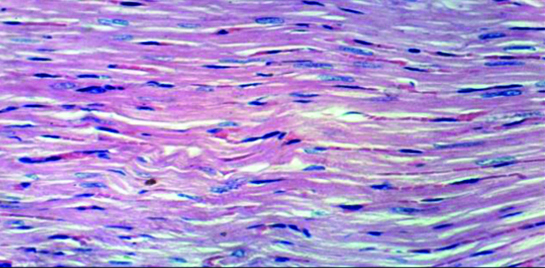
Histopathology of rat heart from control (-) showing normal cardiac myocytes (H&E, X 400).
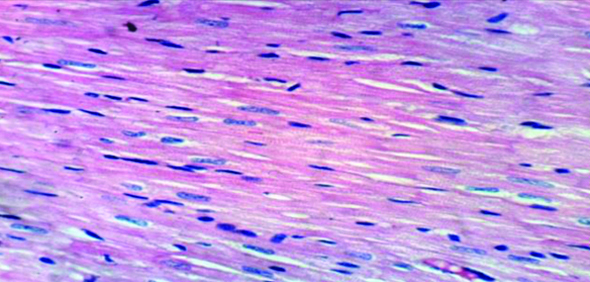
Histopathology of heart of rat from control (+) showing vacuolation of the sarcoplasm of cardiac myocytes and congestion of myocardial blood vessels (H&E, X 400).
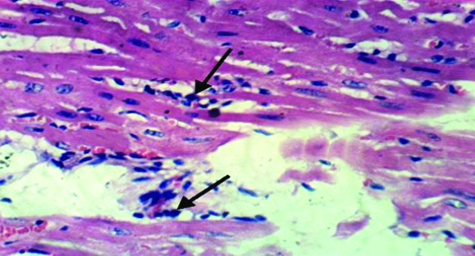
Histopathology of heart of rat from control (+) showing intermuscular inflammatory cells infiltration (H&E, X 400).
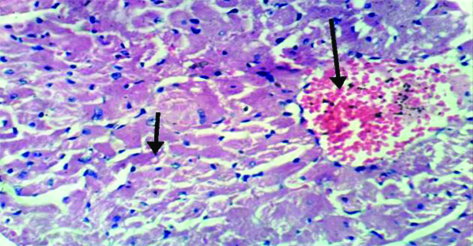
Histopathology of heart of rat from YMP15% showing no histopathological changes (H&E, X 400).
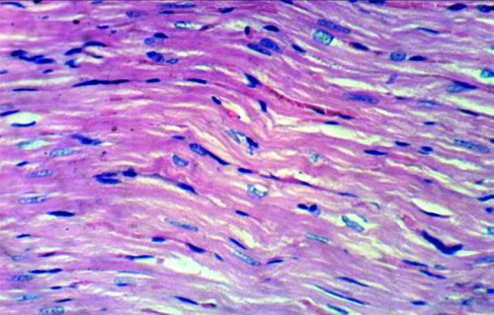
Histopathology of heart of rat from YMP10% showing no histopathological changes (H&E, X 400).
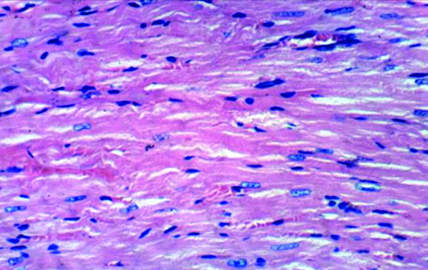
Histopathology of heart of rat from YMB15% showing congestion of myocardial blood vessels (H&E, X 400).
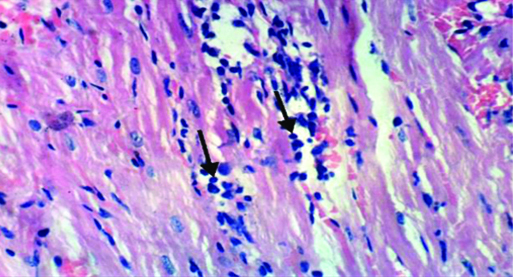
Histopathology of heart of rat from YMB10% showing intermuscular inflammatory cells infiltration (H&E, X 400).
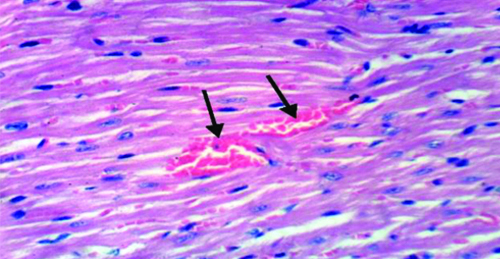
Discussion
Consumption of Yerba mate may exert a beneficial effect on the human state of health. In the present study the values of serum cholesterol triglycerides, LDL-C and VLDL-C mg/dL) showed significant increase (p<0.05) for control positive group when compared with control negative group. Also, the present results are in agreement with Gao H et al., who reported that Yerba mate tea significantly reduces the total body weight and lowers serum levels of total cholesterol, triglyceride, and LDL-C, and causes the increase of serum levels of HDL-C [23]. Treating hypercholesterolemic rats with YMP and YMB (15% and 10%) led to a significant reduction in serum VLDL-C compared with control (+). The present results are in agreement with Concecao EPS et al., who reported that mate tea significantly reduces the total body weight and lowers serum levels of triglyceride and total cholesterol [24].
In the present study, the highest decrease in serum urea nitrogen in all treated groups was found in the group fed on hypercholesterolemic diet containing YMP10%. While the highest increase in serum urea nitrogen was observed in YMB15% group. These results were in accordance with other study which showed that Ilex paraguariensis is able to influence the circulatory system, acting as a diuretic and hypotensive agent. Also, these results agree with Maysa ME who reported that Yerba mate tea decrease uric acid concentration [25]. In the present study, the lowest levels of AST and ALT enzymes were found in group of rats fed on hypercholesterolemic diet along with YMP15%. Our results were supported by those obtained by Martins F et al., who suggested that, mate tea can protect unsaturated fatty acids from oxidation and may have selective protective effects within the body, especially on the liver [26]. Also, Yerba mate infusions were also characterised by a very high antioxidant activity [5]. Data suggested that mate tea has strong antioxidant and lipid-lowering effects that prevents hepatic fatty deposition, and controls the expression of lipid metabolic regulators. It can therefore be used to reduce the risk of atherosclerosis [7]. In the present study, feeding rats on YMP15% showed significant decrease in serum glucose levels as compared to positive control group. The results are in agreement with a study by Kang Y et al., who reported that in-vitro effects of Yerba mate on lipid metabolism leads to reduction in serum glucose concentrations in mice that were fed a high fat diet, therefore, Yerba mate can potentially be used to treat diabetes and obesity [1]. Covering the same ground, some studies showed that Yerba mate has a potential role as an anti-hyperglycaemic substance which may be able to improve the diabetic status and is probably a source of multiple hypoglycaemic compounds. Yerba mate was able to increase antioxidants and increase liver metabolism in rats that were overfed during lactation, possibly through improvements in the hypothalamic action of insulin. These findings may be important for the treatment of obesity-related disorders [27].
Limitation(s)
In the present study, effect of Yerba mate on cholesterol level has been studied but for central obesity it was not studied. Moreover, the small sample size in this study limits the generalisation of the study. Further studies should be done to overcome these limitations.
Conclusion(s)
From the obtained results it can be concluded that, supplementation with high percentage of Yerba Mate powder (15%) exerts a positive impact on the lipid profile and other biochemical parameters in hypercholesterolemic rats. Also, Yerba mate has good effect on lowering the cholesterol levels and has good effect on heart disease and can be used for nutritional recommendation.
Control (-): Control negative; Control (+): Control positive; YMP15%: Yerba mate powder 15%. YMP10%: Yerba mate powder 10%; YMB15%: Yerba mate beverage 15%; YMB10%: Yerba mate beverage 10%; Values are expressed as mean±SD; Significance at p<0.05; Values which don’t share the same letter in each column are significantly different
Control (-): Control negative; Control (+): Control positive; YMP15%: Yerba mate powder 15%; YMP10%: Yerba mate powder 10%; YMB15%: Yerba mate beverage 15%; YMB10%: Yerba mate beverage 10%; Values are expressed as mean±SD; Significance at p<0.05; Values which don’t share the same letter in each column are significantly different
Control (-): Control negative; Control (+): Control positive; YMP15%: Yerba mate powder 15%; YMP10%: Yerba mate powder 10%; YMB15%: Yerba mate beverage 15%; YMB10%: Yerba mate beverage 10%; Values are expressed as mean±SD; Significance at p<0.05; Values which don’t share the same letter in each column are significantly different
Control (-): Control negative; Control (+): Control positive; YMP15%: Yerba mate powder 15%; YMP10%: Yerba mate powder 10%; YMB15%: Yerba mate beverage 15%; YMB10%: Yerba mate beverage 10%; Values are expressed as mean±SD; Significance at p<0.05; Values which don’t share the same letter in each column are significantly different